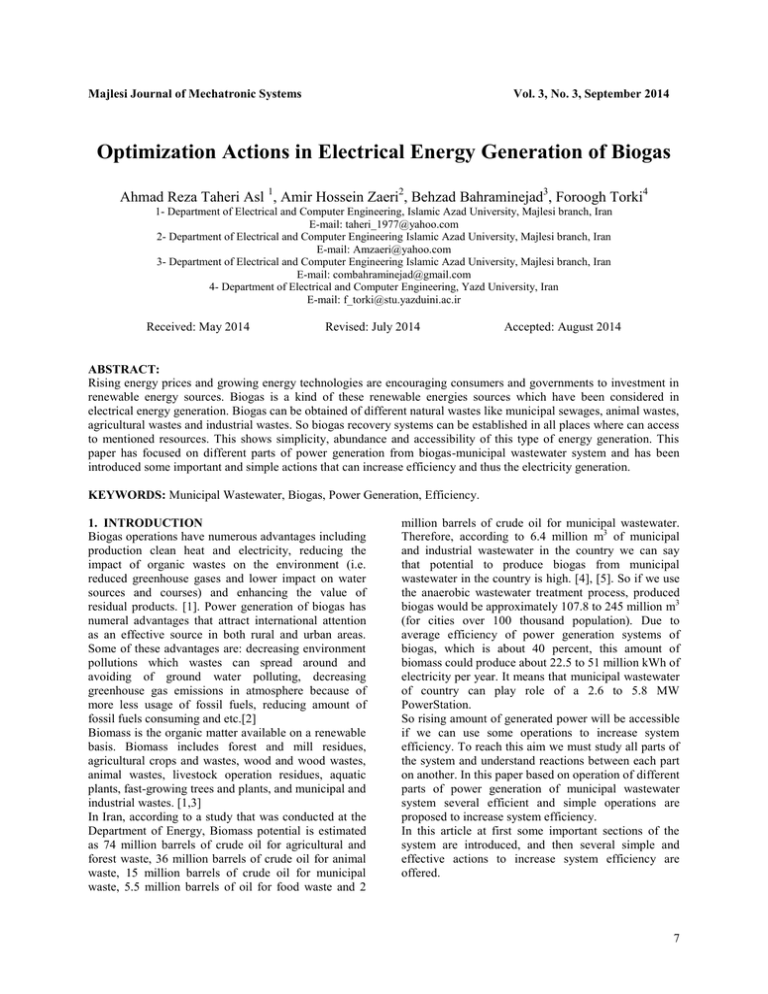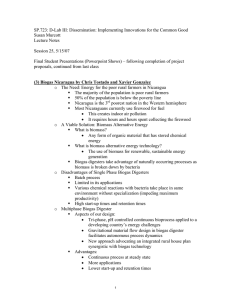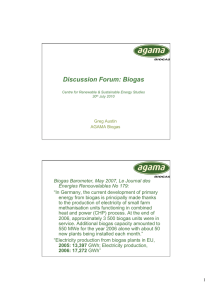Print this article - Majlesi Journal of Mechatronic Systems
advertisement

Majlesi Journal of Mechatronic Systems Vol. 3, No. 3, September 2014 Optimization Actions in Electrical Energy Generation of Biogas Ahmad Reza Taheri Asl 1, Amir Hossein Zaeri2, Behzad Bahraminejad3, Foroogh Torki4 1- Department of Electrical and Computer Engineering, Islamic Azad University, Majlesi branch, Iran E-mail: taheri_1977@yahoo.com 2- Department of Electrical and Computer Engineering Islamic Azad University, Majlesi branch, Iran E-mail: Amzaeri@yahoo.com 3- Department of Electrical and Computer Engineering Islamic Azad University, Majlesi branch, Iran E-mail: combahraminejad@gmail.com 4- Department of Electrical and Computer Engineering, Yazd University, Iran E-mail: f_torki@stu.yazduini.ac.ir Received: May 2014 Revised: July 2014 Accepted: August 2014 ABSTRACT: Rising energy prices and growing energy technologies are encouraging consumers and governments to investment in renewable energy sources. Biogas is a kind of these renewable energies sources which have been considered in electrical energy generation. Biogas can be obtained of different natural wastes like municipal sewages, animal wastes, agricultural wastes and industrial wastes. So biogas recovery systems can be established in all places where can access to mentioned resources. This shows simplicity, abundance and accessibility of this type of energy generation. This paper has focused on different parts of power generation from biogas-municipal wastewater system and has been introduced some important and simple actions that can increase efficiency and thus the electricity generation. KEYWORDS: Municipal Wastewater, Biogas, Power Generation, Efficiency. 1. INTRODUCTION Biogas operations have numerous advantages including production clean heat and electricity, reducing the impact of organic wastes on the environment (i.e. reduced greenhouse gases and lower impact on water sources and courses) and enhancing the value of residual products. [1]. Power generation of biogas has numeral advantages that attract international attention as an effective source in both rural and urban areas. Some of these advantages are: decreasing environment pollutions which wastes can spread around and avoiding of ground water polluting, decreasing greenhouse gas emissions in atmosphere because of more less usage of fossil fuels, reducing amount of fossil fuels consuming and etc.[2] Biomass is the organic matter available on a renewable basis. Biomass includes forest and mill residues, agricultural crops and wastes, wood and wood wastes, animal wastes, livestock operation residues, aquatic plants, fast-growing trees and plants, and municipal and industrial wastes. [1,3] In Iran, according to a study that was conducted at the Department of Energy, Biomass potential is estimated as 74 million barrels of crude oil for agricultural and forest waste, 36 million barrels of crude oil for animal waste, 15 million barrels of crude oil for municipal waste, 5.5 million barrels of oil for food waste and 2 million barrels of crude oil for municipal wastewater. Therefore, according to 6.4 million m3 of municipal and industrial wastewater in the country we can say that potential to produce biogas from municipal wastewater in the country is high. [4], [5]. So if we use the anaerobic wastewater treatment process, produced biogas would be approximately 107.8 to 245 million m3 (for cities over 100 thousand population). Due to average efficiency of power generation systems of biogas, which is about 40 percent, this amount of biomass could produce about 22.5 to 51 million kWh of electricity per year. It means that municipal wastewater of country can play role of a 2.6 to 5.8 MW PowerStation. So rising amount of generated power will be accessible if we can use some operations to increase system efficiency. To reach this aim we must study all parts of the system and understand reactions between each part on another. In this paper based on operation of different parts of power generation of municipal wastewater system several efficient and simple operations are proposed to increase system efficiency. In this article at first some important sections of the system are introduced, and then several simple and effective actions to increase system efficiency are offered. 7 Majlesi Journal of Mechatronic Systems Vol. 3, No. 3, September 2014 2. AN OVERVIEW ON POWER GENERATING SYSTEM OF BIOGAS The diffrence between utilization of biogas from municipal wastewater and other renewable energy sources can be sumerized in four main aspects, energy production, healthy environment, rich fertilizer and raw materials in covers. details and compounds of produced Biogas from municipal wastewater digestion approximatly are shown in Table 1 (it is important to note that each of these parameters can be varied due to changes in the composition of income sewage) [6] Table 1. constituents and characteristics of a sample produced biogas from wastewater a [6] 55-70 %methane, 30-45% Composition carbon dioxide, and trace amounts of other gases. Energy content 6 to 6.5 kW/m3 0.6 to 0.65 liters of fuel per m3 of Fuel equivalent biogas Explosion limits 6 to 12 percent biogas in air Combustion 650 to 750 ° C temperature. Critical pressure 75 to 89 bar Critical 82.5 ° C temperature Normal density 1.2 kg/m3 Rotten eggs (hydrogen sulfide odor odor) In general, regardless of the source of biogas production, generation and use of biogas process can be seen in Figure 1. Fig. 1. Constituent parts of power generating system from biogas According to this figure1, it can be seen that the mechanical and electrical energy required in every place and process can be achieved by installing the appropriate equipment. It means that thermal energy can be created by burning biogas and convert it into required mechanical and electrical energy in industries, farms, and any other place. In other words, a wastewater treatment plant where produces biogas and then electricity will be produced from biogas is comprised of 10 units that can be seen in figure 2. [4] Fig. 2. Schematic graph of power and biogas generation in wastewater refinery process [4] 8 Majlesi Journal of Mechatronic Systems Units 1 and 2 which collectively are called primary treatment are responsible of suspended solids removal from wastewater and preparation sewage for entering to secondary treatment. Sections of the primary treatment include trash-stuck, sedimentation, flotation, neutralization and balancing. The factor that is important in this unit is the amount of Biological Oxygen Demand (BOD) in incoming sewage. According to what will be presented in the next section control of this factor can increase system efficiency. [7], [8], [9] Unit 3, Secondary treatment, is includes all biological treatment processes which are done in both aerobic and anaerobic treatment. Conventional methods of secondary treatment of sewage include: Activated sludge method, Continuous aeration and Aerated lagoons. Unit 4, digester, is the most important part of the biogas production system. Because of most main factors to control quality and quantity of biogas, are available in this unit. In other words, by controlling these factors in this unit, quality and volume of biogas and electricity can be administrated. Digesters are divided into two types, Aerobic and anaerobic, that anaerobic type is used in the biogas production from municipal wastewater. [8] Anaerobic digester is a tank sealed which mud is entered to it and heated. In the absence of oxygen, anaerobic bacteria grow by consuming solid waste sectors and produce methane and carbon dioxide (biogas). Efficiency of anaerobic digesters depends on providing appropriate environment for bacteria and feeding them. [8] Units 5 and 6 are responsible for guarantying quality and pressure of biogas before entering to power generation unit. Currently, due to inadequate controls in this unit, instability in power generation is seen. Some simple actions are suggested in next section to increase stability and efficiency of power generation. [7] Unit 6 and 7 are consisting of one or more gas engines and convertor devices to generate electricity. It's obvious that efficiency of engines and convertors can affect the efficiency of the entire system. 3. SIMPLE ACTIONS TO INCREASE SYSTEM EFFICIENCY As mentioned in the previous section biogas production systems from municipal wastewater which have already been designed and implemented have flaws and defects that greatly reduce system efficiency. In this paper some strategies are presented to overcome these deficiencies. 3.1. Adding extra equipment in digestion mixture process Vol. 3, No. 3, September 2014 As mentioned in the previous section, the efficiency of anaerobic digester depends on suitable environment and nutrients for bacteria. Since the bacteria have no ability to move themselves, so mixing can be effective in increasing the efficiency of anaerobic digester. Now the mixing operation is accomplished by a mixer which is controlled by a motor with variable speed. But sometimes it's not enough for mixing. For example, when temperature of the sludge of digester decreases, because of cooling down the environment or entering cold sewage from treatment plant, bacterial growth rate reduce and rate of biogas production decrease. Therefore, side operations such as heating content of digester and injecting obtained gas into the digester could make mixing operations more effective. Unavailable or insufficient food for bacteria is limiting activity of bacterial and PH Value of the digester contents goes to acidic environment. Thus measuring the PH can be an appropriate metrics for controlling mixing operation. Increasing speed of mixers can be effective in primary controlling the process. But if it is not effective, lateral and auxiliary operations can be used to improve the bacteria environment. One of which is the addition of buffering materials. One factor in this case is to increase the bio temperature of the bacteria. Raising temperature of digester in emergency situations by lateral processes can help to reduce its acidity. So temperature of some points inside the digester is measured by some sensors and calculated subtraction of them to predict temperature changes of digester environment in future. So before creating acidic environment, temperature of the digester begins to rise. Therefore, use of heat exchangers in the digester is proposed. These exchangers can be selected from two central and side Heat exchangers. It is noteworthy that in order to recovery exhaust heat of gas engines and reduce energy consumption, output steam or hot water of gas engine (is called CHP unit) can be used. Another effort which can be effectively in improving the mixing process is injection the obtained gas into the digester environment. If bacteria living environment is far from prepare situation, amount of gas produced by them will be decreasing. This causes that gas pressure in top of the digester tank decline. While for receiving gas from the digester continuously (which is one of the main objectives) pressure at top of the digester should be always positive and higher than a certain level. The pressure much less means that environment is not suitable for bacteria. Therefore, ambient air is introduced into the digester and causing the digester goes out of anaerobic state. So the growth of bacteria and methane-making process will disrupt. Therefor pressure changes at top of digester can show PH changes. One of simple actions to increase the gas 9 Majlesi Journal of Mechatronic Systems Vol. 3, No. 3, September 2014 pressure at top of the digester and control PH will be injecting into the digester from the bottom. For this purpose, a storage tank of gas can be used before the gas refinery unit. By creating a return way of the tank to the bottom of digester we can inject gas into the sludge in digester when necessary. This suggestion can be seen in figure 3. Fig. 4. Locating a secondary tank to storage sludge 3.3. Implementing an automatic control system between wastewater treatment, biogas production and electricity generation units Fig. 3. equipment Location to assist the mixing process 3.2. Adding a storage tank next to the digester Various factors may affect amount of produced gas by the bacteria in the digester. The most important of them are retention time of sludge in the digester and sludge concentration inside the digester. If these two factors could be close to the ideal conditions, efficiency of gas production will be increased. It is possible that during a period of time amount of wastewater entering the plant increase. So amount of sludge to digester enters in much higher speeds. Therefor digester sludge has to remove before the desired retention period, 10 days, from the digester and forcibly replaced with fresh, non-processed sludge. This leads to exclude the processed sludge, which is ready to produce gas, from the process before reaching the peak gas production. This will reduce the efficiency of the digester and biogas systems. On the other hand, if for various reasons, such as rainfall, the concentration of sludge in the pools before digester decreases, the diluted sludge will enter to the digester and gas production will greatly reduce. It can also reduce efficiency of system like the previous operating. A simple solution that is suggested is storing rich and processed sludge in a storage tank for use in emergency situations. Figure 4 shows location of devices for storage slog. 10 Biogas production systems which are already being used are not able to control the process instantaneous and complete and don't have full-duplex and complete connection with the collection system and wastewater treatment. While the interaction between these two systems, and more electrical energy generation system by biogas is very important to increase efficiency and reduce human errors. [9], [10] So by implementing an online and real-time monitoring system, In addition to continuous sampling, analysis samples and storage results in long-term memory, we can send the results in adjustable intervals through a variety of online communication medias to central control and monitor point. 3.4. Increasing power plant efficiency In addition to the solutions that have already been presented in different parts of biogas production system, some actions are that can improve efficiency of power generation system. One of the easiest and most inexpensive ways is cooling the incoming air to the gas turbines. By an absorption chiller to cool the intake air can increase the area under the graph of pressure vs. volume and increase plant efficiency. These actions are shown in figure 5. Fig. 5. Schematic of increasing power plant Majlesi Journal of Mechatronic Systems Vol. 3, No. 3, September 2014 4. CONCLUSION In this paper we propose some simple and low cost instruments to optimize power generation from wastewater system. These actions can be used in all parts of the system: wastewater refinery plant, biogas production of wastewater sludge and power generation of biogas. These help power generation process in critical conditions to repair itself faster. REFERENCES [1] Report for Alberta Agriculture, Food and Rural Development, "Biogas Energy Electricity Generation and Interconnection to the Power Grid", 2006. [2] Taheri Asl, reihani, Naderi Fasarani, Mostafavi, “Potentiometer, made by biogas-burning power plant in sewage treatment plants” the 9th international Energy Assembl.y. [3]. Bodík, S., Sedláèek, M., Kubaská and M., Hutòan, “Biogas Production in Municipal Wastewater Treatment Plants –Current Status in EU with a Focus on the Slovak Republic”, Original scientific paper, Slovak University of Technology, July 27, 2011. [4] A., Taheri Asl, M., Malekiha, K., Movassaghi and F., Adani., “New Method for Biogas Generation from Municipal Wastewater Treatment Plant of Isfahan City, Iran” Eurasia 2014 Waste Management Symposium. Istanbul, Turkey. [5] M., Adl, Gh.A., Omrani.. "Background of biogas technology and its recent developments in Iran", International Journal of Global Energy Issues, Vol. 29, No. 3, pp. 273-283, 2003. [6]. Z., Hanjie..“Sludg Treatment to Increase Biogas Production. Trita-Lwr”, Degree Project , pp.10-20, August 2010 [7]. D.,. Mane , D., Robescu, and A., Presura. “Sustainable Energy In Waste Water Treatment Plants”. ISSN 1454-2358. 2012. [8] S., Stillwell, D.C., Hoppock, Michael E., Webber "Energy Recovery from Wastewater Treatment Plants in the United States: A Case Study of the Energy-Water Nexus," Ph.D. Sustainability, 2, 945962; doi:10.3390/su2040945, 2010. [9] R., Volpe., “Techniques for Collision Prevention, Impact Stability, and Force Control by Space Manipulators,” Teleoperation and Robotics in Space, edited by S. B. Skaar and C. F. Ruoff, Progress in Astronautics and Aeronautics, AIAA, Washington, DC, pp. 175–212, 1994. [10]. P.A., Vanrolleghem..“ Model Based Control Of Waste Water Treatment Plants. Department Applied Mathematics”, Biometrics and Process Control University of Gent, Coupure Links 653, B9000 Gent, Belgium. 11






